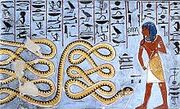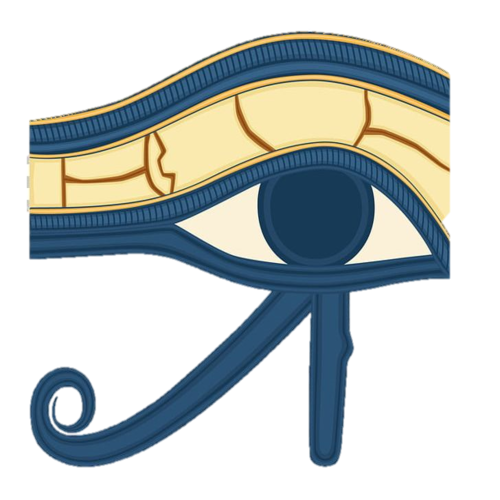| Apep | ||||
|---|---|---|---|---|
| Greek: Apophis | ||||
| ||||
 Ra in the form of a cat, slaying Apep. | ||||
| Period of worship |
First Intermediate Period – Roman Period | |||
| Cult center | None | |||
| Titles | "Enemy of Ra" "Lord of Chaos" "Serpent of the Nile" | |||
| Symbol(s) | Serpent | |||
| Association | Chaos, darkness | |||
| Appearance | Serpent | |||
| Egyptian equivalent(s) |
Set | |||
| Mother | Neith | |||

Set spearing Apep.

Apep, or Apophis, was the Egyptian god of evil and darkness, until Set became the main symbol of evil in the later ages. Apep was usually depicted as an evil serpent that would battle Ra and bring darkness to the world.
Battles with Ra[]
Apep was given the title, Enemy of Ra,because he would always battle with the sun god Ra Apep had a fa other gods that travelled with him. The most powerful defender Ra had with him was Set, who had not yet turned evil. Since it was obvious a snake and the sun were not fighting during the day, the people believed that Apep was waiting for Ra at sunset behind Bahku, a mountain in the west; or right before dawn. Apep occasionally managed to swallowed Ra, and the Egyptians believed that is what caused solar eclipses. It was also said that when Ra and Apep would battle, it would cause all of the earthquakes and thunderstorms in the
Worship[]
Apep was not worshipped, only worshipped against. The Egyptians carried out multiple superstions and rituals thought to aid Ra in his battle against Apep. In an annual ceremony, called the Banishing of Apep, the priests would build a box thought to contain all the evil of Apep, and then burn it. The people would then be saved from Apep's influence for one year. The Egyptian priests even had a detailed guide on how to defeat Apep called, The Books of Overthrowing Apep, which gave a gradual and detailed description of how to dismember and dispose of the evil snake. This book contained stories of Apep's defeat. In addition to the stories of defeat the book explained how to make wax models or drawings of the serpent to be spat on ore mutilated while saying spells to aid Ra. Apep was thought to live in the Underworld, so the Egyptians believed the dead needed protection to. In the Book of the Dead, spell seven and thirty-nine are spells to destroy Apep once you were dead.
Development[]
Ra was the Solar Deity, bringer of light, and thus the upholder of Ma'at. Apep was viewed as the greatest enemy of Ra, and thus was given the title Enemy of Ra.
As the personification of all that was evil, Apep was seen as a giant snake/serpent, or occasionally as a dragon in later years, leading to such titles as Serpent from the Nile and Evil Lizard. Some elaborations even said that he stretched 16 yards in length and had a head made of flint. Already on a Naqada I (ca. 4000 BC) C-ware bowl (now in Cairo) a snake was painted on the inside rim combined with other desert and aquatic animals as a possible enemy of a deity, possibly a solar deity, who is invisibly hunting in a big rowing vessel.[1]
Also, comparable hostile snakes as enemies of the sun god existed under other names (in the Pyramid Texts and Coffin Texts) already before the name Apep occurred. The etymology of his name (ꜥꜣpp) is perhaps to be sought in some west-semitic language where a word root ꜣpp meaning 'to slither' existed. A verb root ꜥꜣpp does at any rate not exist elsewhere in Ancient Egyptian. (It is not to be confused with the verb ꜥpı͗/ꜥpp: 'to fly across the sky, to travel') Apep's name much later came to be falsely connected etymologically in Egyptian with a different root meaning (he who was) spat out; the Romans referred to Apep by this translation of his name. Apophis was a large golden snake known to be miles long. He was so large that he attempted to swallow the sun every day.
Set eventually became thoughtof as the god of evil, and gradually took on all the characteristics of Apep. Consequently, Apep's identity was eventually entirely subsumed by that of Set.[2]
Battles with Bastet[]
Tales of Apep's battles against Ra were elaborated during the New Kingdom.[6] Since everyone can see that the sun is not attacked by a giant snake during the day, every day, storytellers said that Apep must lie just below the horizon. This appropriately made him a part of the underworld. In some stories Apep waited for Ra in a western mountain called Bakhu, where the sun set, and in others Apep lurked just before dawn, in the Tenth region of the Night. The wide range of Apep's possible location gained him the title World Encircler. It was thought that his terrifying roar would cause the underworld to rumble. Myths sometimes say that Apep was trapped there, because he had been the previous chief god overthrown by Ra, or because he was evil and had been imprisoned. In his battles, Apep was thought to use a magical gaze to hypnotize Ra and his entourage, attempting to devour them whilst choking the river on which they traveled through the underworld with his coils. Sometimes Apep had assistance from other demons, named Sek and Mot. Ra was assisted by a number of defenders who travelled with him, the most powerful being Set, who sat at the helm. In a bid to explain certain natural phenomena it was said that occasionally Apep got the upper hand. The damage to order caused thunderstorms and earthquakes. Indeed: it was even thought that sometimes Apep actually managed to swallow Ra during the day, causing a solar eclipse, but since Ra's defenders quickly cut him free of Apep, the eclipse always ended within a few minutes. On the occasions when Apep was said to have been killed, he was able to return each night (since he lived in the world of the dead already). However, in other myths, it was the cat goddess Bastet, daughter of Ra, who slew Apep in her cat form one night, hunting him down with her all seeing eye.
Worship[]
Ra was worshipped, and Apep worshipped against. Ra's victory each night was thought to be ensured by the prayers of the Egyptian priests and worshipers at temples. The Egyptians practiced a number of rituals and superstitions that were thought to ward off Apep, and aid Ra to continue his journey across the sky. In an annual rite, called the Banishing of Chaos, priests would build an effigy of Apep that was thought to contain all of the evil and darkness in Egypt, and burn it to protect everyone from Apep's evil for another year, in a similar manner to modern rituals such as Zozobra. The Egyptian priests even had a detailed guide to fighting Apep, referred to as The Books of Overthrowing Apep (or the Book of Apophis, in Greek).[7] The chapters described a gradual process of dismemberment and disposal, and include:
Spitting Upon Apep Defiling Apep with the Left Foot Taking a Lance to Smite Apep Fettering Apep Taking a Knife to Smite Apep Putting Fire Upon Apep
In addition to stories about Ra's winnings, this guide had instructions for making wax models, or small drawings, of the serpent, which would be spat on, mutilated and burnt, whilst reciting spells that would kill Apep. Fearing that even the image of Apep could give power to the demon any rendering would always include another deity to subdue the monster. As Apep was thought to live in the underworld, he was sometimes thought of as an Eater of Souls. Thus the dead also needed protection, so they were sometimes buried with spells that could destroy Apep. The Book of the Dead does not frequently describe occasions when Ra defeated the chaos snake explicitly called Apep. Only BD Spells 7 and 39 can be explained as such.[8]
